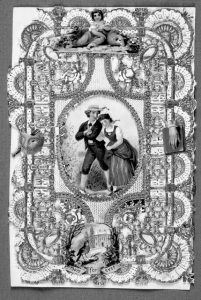
James Shockley
To the one I love … or hate. Valentines can go both ways. Most express feelings of love, but a few, usually sent anonymously, have shown feelings of animosity.
I remember that last kind in the form of grotesque “comic” valentines which kids in my second grade class claimed they were sending to the teacher. More recently that kind of card has been replaced by cards with funny verses.
Valentines of a sort have been with us since about 1400, when Germans sent notes of love on cards printed from woodcuts. Following a long tradition, these were sent out on Feb. 14. The custom became widespread when the printing press was invented later that century.
The English have an old valentine tradition that we would not recognize today. In the 17th century, it was customary to draw names from an urn to select couples to be assigned as “Valentines” for the year—much as some clubs now have “special sisters” or large families might draw names to assign Christmas presents.
Notes were written in verse to send to the partner. Often the valentine partnership would involve elaborate gifts, frequently in the form of gloves for the women. Being a valentine did not necessarily involve a romantic statement, but, as the following verse shows, that was a possibility:
Love, to thee I send these gloves,
If you love me,
Leave out the G,
And make a pair of Loves.
The early valentine cards were handmade. Since most people were not poets, books of appropriate verses were available. Some of these books had verses designed for different professions: Carpenters, bricklayers, etc.
Here is a verse to be sent by a young woman to her lover who has offered to build a beautiful home for the two of them:
My charmer, my sweet,
I will kneel at your feet,
And to your fond wishes incline:
Your mansion so great,
So charming and neat,
Will please your own valentine.
These books also included “bad” valentines such as the following verse for a gentleman to send to a lady who had betrayed him in the past:
You’re a double-faced creature and full of conceit,
For back-biting slander you cannot be beat,
Such a venomous hussy can seldom be found,
You are known as a vixen for miles around,
So don’t try your tricks any more upon me,
For through all of them I can easily see!
In the 19th century, the printing process developed more capability, and printed valentines became popular throughout Europe.
It is estimated that 200,000 valentines were circulated in London during the mid 1820’s. These were printed in Europe, mostly in England and Germany.
In the 1840s, when she was 19 years old, Esther Howland of Worcester, Massachusetts, received an imported valentine. She was a talented artist and decided to go into the valentine card business in a small way.
Her father ordered some supplies for her, she made a few sample valentines, and her salesman brother showed them on his business trips to stationery stores.
Hoping for about $200 in orders, she was amazed (and probably overwhelmed) when her brother returned with orders worth more than $5,000. (That was equivalent to over $150,000 in today’s currency.)
She met the challenge, converted an unused bedroom into a factory, and hired local women to make the cards. For efficiency, she set up an assembly line where the different stages of manufacturing were done by different people.
She designed the valentines and made templates for the ladies to use. A simple card sold for five cents, but more elaborate ones, those with many layers of paper lace and pictures, could sell for as much as $15.00 (about $450.00 in today’s money).
Her cards caught on in a big way. Soon other American manufacturers got into the business, but she remained the leader.
Later, when her parents aged and were in bad health, she sold the business and retired to devote her life to their care.
Publishers knew that valentines and Christmas cards have limited sales periods; so they branched out with birthday cards, get well cards, friendship cards, etc.
Aggressive sales techniques have brought the industry into bad repute in some quarters, but most people enjoy getting an appropriate card, especially on Valentine’s Day.
Personally, I like valentines in the form of heart-shaped boxes full of chocolate candy.
James Shockley writes a monthly history column. He lives in Blacksburg.



